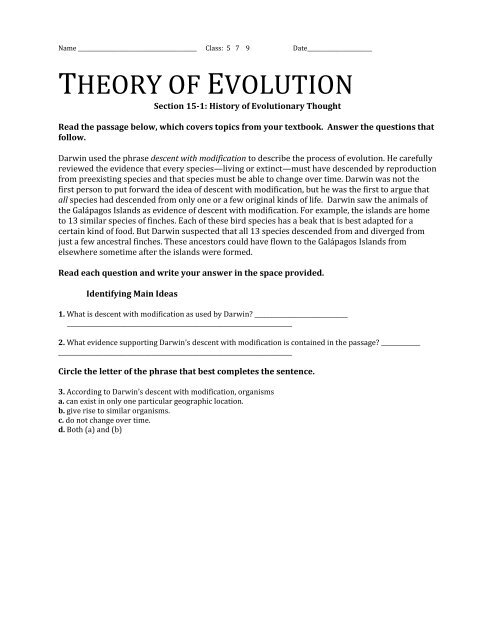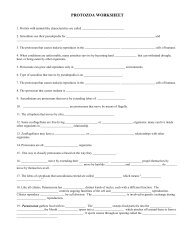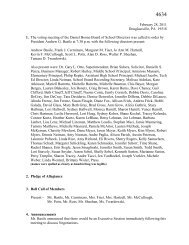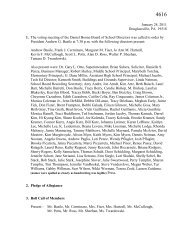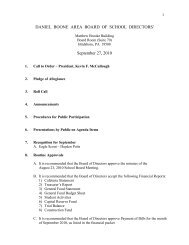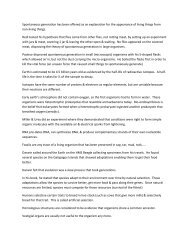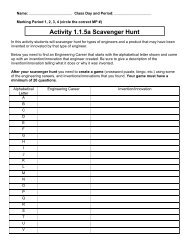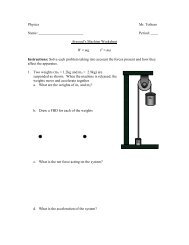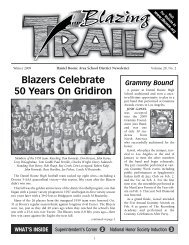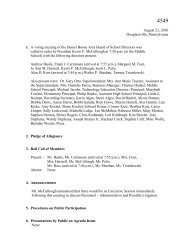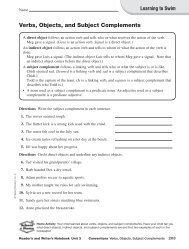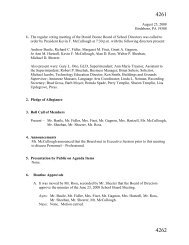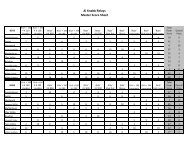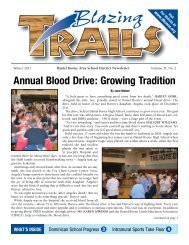THEORY OF EVOLUTION
THEORY OF EVOLUTION
THEORY OF EVOLUTION
Create successful ePaper yourself
Turn your PDF publications into a flip-book with our unique Google optimized e-Paper software.
Name ____________________________________________ Class: 5 7 9 Date________________________<br />
CHAPTER 15 ACTIVE READING WORKSHEETS<br />
<strong>THEORY</strong> <strong>OF</strong> <strong>EVOLUTION</strong><br />
Section 15-1: History of Evolutionary Thought<br />
Read the passage below, which covers topics from your textbook. Answer the questions that<br />
follow.<br />
Darwin used the phrase descent with modification to describe the process of evolution. He carefully<br />
reviewed the evidence that every species—living or extinct—must have descended by reproduction<br />
from preexisting species and that species must be able to change over time. Darwin was not the<br />
first person to put forward the idea of descent with modification, but he was the first to argue that<br />
all species had descended from only one or a few original kinds of life. Darwin saw the animals of<br />
the Galápagos Islands as evidence of descent with modification. For example, the islands are home<br />
to 13 similar species of finches. Each of these bird species has a beak that is best adapted for a<br />
certain kind of food. But Darwin suspected that all 13 species descended from and diverged from<br />
just a few ancestral finches. These ancestors could have flown to the Galápagos Islands from<br />
elsewhere sometime after the islands were formed.<br />
Read each question and write your answer in the space provided.<br />
SKILL: Identifying Main Ideas<br />
1. What is descent with modification as used by Darwin? _______________________________<br />
___________________________________________________________________________<br />
2. What evidence supporting Darwin’s descent with modification is contained in the passage? _____________<br />
______________________________________________________________________________<br />
Circle the letter of the phrase that best completes the sentence.<br />
3. According to Darwin’s descent with modification, organisms<br />
a. can exist in only one particular geographic location.<br />
b. give rise to similar organisms.<br />
c. do not change over time.<br />
d. Both (a) and (b)
<strong>THEORY</strong> <strong>OF</strong> <strong>EVOLUTION</strong><br />
Section 15-2: Evidence of Evolution<br />
Read the passage below, which covers topics from your textbook. Answer the questions that<br />
follow.<br />
In 1668, Robert Hooke published his conclusion that fossils are the remains of plants and animals.<br />
Hooke was one of the first scientists to study fossils, principally petrified wood, with the aid of a<br />
microscope.<br />
Hooke thought the detail he saw with the microscope was too fine and precise to have been formed<br />
by the rock itself. He hypothesized that living organisms had somehow been turned to rock.<br />
Hooke’s view was shared by another scientist of his time, Nicolaus Steno. In 1669, Steno proposed<br />
the principle of superposition, which states that successive layers of rock or soil were deposited<br />
on top of one another by wind or water. The lowest stratum, or layer, in a cross section of Earth is<br />
the oldest, while the top stratum is the most recent. Thus, fossils within a single stratum are of the<br />
same approximate age. Using Steno’s principle, observers could establish the relative age of a<br />
fossil; that is, they could say that a given fossil was younger or older than another fossil. The fossil’s<br />
absolute age (its age in years) could be estimated from the amount of sediment deposited above<br />
the fossil or by using the radiometric dating of a nearby rock layer.<br />
Fill in the blank to complete each sentence.<br />
SKILL: Sentence Completion<br />
One reading skill is the ability to complete an incomplete sentence by logically determining<br />
what will complete the unfinished thought.<br />
1. Robert Hooke was one of the first scientists to study fossils through a _________________________________________ .<br />
2. His observations led Hooke to conclude that fossils are the remains of ________________________________________ .<br />
3. According to the principle of superposition, fossils in the same stratum are about _______________________ .<br />
Circle the letter of the word or phrase that best completes the statement.<br />
4. The top stratum in a cross section of Earth is the<br />
a. youngest.<br />
b. layer most likely to contain fossils.<br />
c. oldest.<br />
d. Both (a) and (b)
<strong>THEORY</strong> <strong>OF</strong> <strong>EVOLUTION</strong><br />
Section 15-3: Evolution in Action<br />
Read the passage below, which covers topics from your textbook. Answer the questions that<br />
follow.<br />
The change of two or more species in close association with each other is called co<br />
evolution. Predators and their prey sometimes co evolve, parasites and their hosts often co<br />
evolve, and plant eating animals and the plants they feed on also co evolve. One example of co<br />
evolution is plants and the animals that pollinate them. Sometimes, organisms that appear to be<br />
very similar, such as a shark and a porpoise, are not closely related at all. This kind of similarity is<br />
the result of convergent evolution. Convergent evolution occurs when the environment selects<br />
similar phenotypes, even though the ancestral types were quite different from each other.<br />
Analogous structures, such as similar fins in very different animals, are associated with convergent<br />
evolution.<br />
In divergent evolution, two or more closely related populations or species become more<br />
and more dissimilar. Divergence is nearly always a response to differing environments, and it can<br />
ultimately result in new species. Sometimes, the process of divergence can be sped up artificially<br />
through artificial selection. All domestic dogs are the same species, Canis familiaris. Dogs have<br />
been bred by humans for certain phenotypic characteristics, resulting in different breeds with<br />
different traits.<br />
Refer to the passage to complete the graphic organizer below.<br />
SKILL: Organizing Information<br />
Patterns of Evolution<br />
Evolution Pattern Example<br />
1. 3. Parasites & their hosts<br />
Convergent evolution 4. 5.<br />
2. 2 or more related species 6.<br />
or populations become<br />
more and more<br />
dissimilar, often due to<br />
differing habitats<br />
P<br />
Circle the letter of the word or phrase that best completes the sentence.<br />
7. Artificial selection can sometimes speed up the process of<br />
a. convergent evolution.<br />
b. co evolution.<br />
c. divergent evolution.<br />
d. Both (a) and (b)erns of Ev
Modern Biology Vocabulary Review<br />
In the space provided, write the letter of the term or phrase that best completes<br />
each statement or best answers each question.<br />
______ 1. The process in which organisms with traits well suited to an environment<br />
are more likely to survive and to produce offspring is<br />
a. trait mechanisms. c. genetic principles.<br />
b. origin of species. d. natural selection.<br />
______ 2. Most scientists agree that<br />
a. Earth is about 3.5 million years old. b. life is new on Earth.<br />
c. living organisms share ancestry. d. intermediate fossils do not exist.<br />
______ 3. A change in the genetic makeup of species over time is called<br />
a. radioactive dating. c. camouflage.<br />
b. evolution. d. fossilization.<br />
______ 4. The process by which a species becomes better suited to its environment is<br />
a. artificial selection. c. adaptation.<br />
b. not an advantage. d. destructive to its survival.<br />
______ 5. Structures that share a common ancestry or are similar because they are modified<br />
versions of structures from a common ancestor are<br />
a. not related. c. not homologous.<br />
b. homologous. d. young in origin.<br />
______ 6. Structures with no function that are remnants of an organism’s evolutionary past<br />
are<br />
a. not visible on organisms. c. vestigial.<br />
b. young in origin. d. useful to the organism.<br />
______ 7. Species that share a common ancestor<br />
a. have many amino acid sequence differences.<br />
b. have few amino acid sequence differences.<br />
c. have identical nucleotide sequences.<br />
d. are not represented by the fossil record.<br />
______ 8. Individuals that have traits that enable them to survive in a given environment can<br />
reproduce and<br />
a. begin the process of co evolution.<br />
b. pass on those traits to their offspring.<br />
c. slow the process of evolution.<br />
d. All of the above
______ 9. Populations of a species that now differ genetically because they have adapted to<br />
different living conditions have undergone<br />
a. convergent evolution. c. adaptive radiation.<br />
b. artificial selection. d. coevolution.<br />
______10. Which of the following statements was NOT suggested by Darwin?<br />
a. Natural selection is the mechanism that drives evolution.<br />
b. Antibiotic-resistant strains of bacteria have evolved by natural<br />
selection.<br />
c. There are many examples of how natural selection has shaped life<br />
on Earth.<br />
d. The beak shapes of the finches of the Galápagos are determined by<br />
natural selection.<br />
______11. Which of the following is a factor in natural selection?<br />
a. Individuals of a species compete with one another to survive.<br />
b. All species are genetically diverse.<br />
c. Individuals better able to adapt to changes leave more offspring.<br />
d. All of the above<br />
______12. When a species permanently disappears, the species is said to be<br />
a. extinct. b. rare. c. adapted. d. eliminated.<br />
______13. The adaptation of bacteria to survive the effects of antibiotics is called<br />
a. resistance. b. convergence. c. divergence. d. elimination.<br />
______14. The fossil record provides evidence that<br />
a. older species gave rise to more-recent species.<br />
b. all species were formed during Earth’s formation and have<br />
changed little since then.<br />
c. fossilized species have no connection to today’s species.<br />
d. fossils cannot be dated.<br />
______15. Individuals that are better able to cope with the challenges of their environment<br />
tend to<br />
a. decrease in population over time.<br />
b. leave more offspring than those more suited to the environment.<br />
c. leave fewer offspring than those less suited to the environment.<br />
d. leave more offspring than those less suited to the environment.<br />
______16. The pelvic bones of modern whales no longer function like the pelvis of a land<br />
vertebrate and are an example of<br />
a. an analogous structure. c. a vestigial structure.<br />
b. a homologous structure. d. coevolution.


